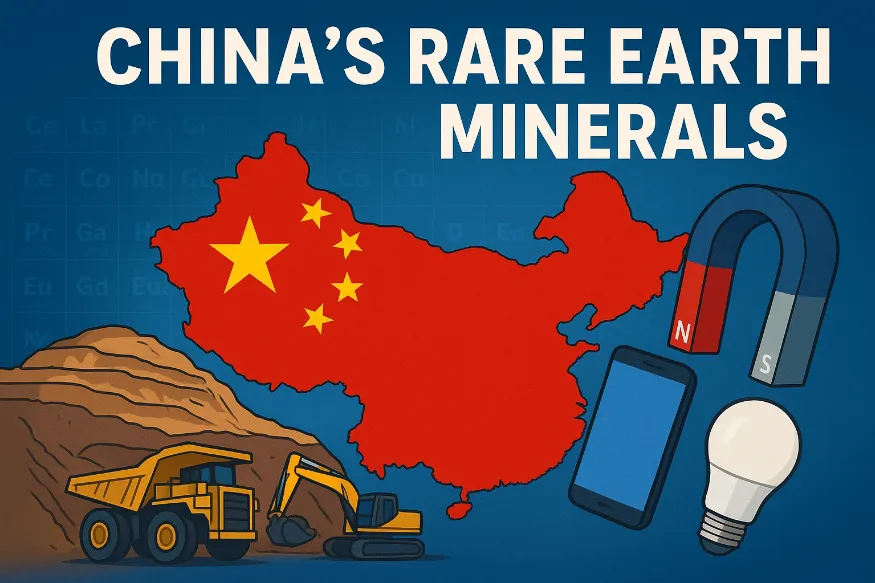Rare earth minerals are a group of 17 metallic elements that are essential to modern technology, renewable energy, and defense industries. They include elements like neodymium, dysprosium, cerium, and yttrium, which are used in everything from smartphones and electric vehicles to satellites and fighter jets. Although these elements are not truly “rare” in nature, they are difficult to extract and refine, making them strategically important.
China’s Position in Rare Earths
China is the world’s largest producer, refiner, and exporter of rare earth minerals. It has secured its dominance over decades by investing heavily in mining, refining capacity, and global supply chains. Currently, China controls about 60–70% of global rare earth production and holds roughly 40% of known reserves.
Major Deposits in China
- Bayan Obo (Inner Mongolia) – The world’s largest Rare Earth Minerals mine, providing mostly light rare earth elements (LREEs) such as neodymium, cerium, and lanthanum.
- Mianning (Sichuan Province) – Another significant deposit, contributing heavily to the supply of light rare earths.
- Southern Provinces (Jiangxi, Guangdong, Hunan, Guangxi, Fujian, Yunnan) – Rich in ion-adsorption clays, these areas are a major source of heavy rare earth elements (HREEs) like dysprosium, terbium, and yttrium, which are more scarce and valuable.
Types of Rare Earths China Produces
- Light Rare Earth Minerals (LREEs):
- Lanthanum, Cerium, Praseodymium, Neodymium, Samarium
- Widely used in catalysts, glass, and magnets.
- Heavy Rare Earth Minerals (HREEs):
- Dysprosium, Terbium, Yttrium, Europium, Gadolinium
- Crucial for high-performance magnets, lasers, and defense technology.
Applications of China’s Rare Earth Minerals
China’s rare earths feed industries worldwide. Key applications include:
- Permanent Magnets: Neodymium and dysprosium are used in magnets for electric vehicles, wind turbines, and smartphones.
- Consumer Electronics: Europium, terbium, and yttrium are used in screens, LEDs, and displays.
- Clean Energy: Rare earths are vital for batteries, solar panels, and green energy infrastructure.
- Defense Systems: Guidance systems, radar, communication equipment, and precision weapons rely on rare earths.
- Industrial Use: Cerium is widely used for glass polishing, while lanthanum is used in camera lenses and catalysts.
Strategic Importance of China’s Rare Earth Control
China’s dominance in rare earths is not just economic but also geopolitical. By controlling the supply and refining of these elements, China can influence global technology and defense industries. In 2010, China restricted exports of rare earths to Japan after a diplomatic dispute, showing how these resources can be used as a strategic tool.
Today, rare earths are often referred to as “China’s oil of the 21st century.” With global demand rising due to the shift toward renewable energy and electric vehicles, China’s position in this market gives it powerful leverage.
Environmental Challenges
Rare earth mining is resource-intensive and environmentally damaging. In regions like Inner Mongolia, mining has caused radioactive waste, soil contamination, and water pollution. In response, China has tightened regulations and invested in greener extraction methods, but environmental costs remain a major concern.
- BMI Calculator
- Firozabad AQI:कांच की चमक के पीछे धुंधलाता
- 2026 Kia Seltos HTE ने ‘Base Model’ की परिभाषा बदल दी है?
- Global Hunger Index (2026): स्थिरता और संकट के बीच जूझती दुनिया
- Firozabad ka aqi kitna hai
Global Shifts and Competition
Other countries, including the United States, Australia, and India, are working to reduce reliance on China by developing their own rare earth mines and refining technologies. However, since China dominates not only mining but also processing and refining, it will likely remain the global leader for years to come.
✅ In summary: China’s rare earth minerals are the backbone of modern technology and green energy. With massive reserves, unmatched refining capacity, and a strong grip on exports, China holds one of the most strategic resources of the 21st century.
- iPhone 17 Pro Max Launch Date: 10 Reasons to Wait for iPhone 17 Series
- Green Vegetables Benefits – हरी सब्ज़ी खाने से होने वाले 10 बड़े फायदे
- क्या BRICS देश मिलकर अपनी मुद्रा बना सकते है?
- QUAD की बैठक; India-America की तनातनी के बीच क्या रद्द होगी ?
- JPG to PNG to WEBP converter
- Convert Any File Into PDF
- Facts About Tomatoes That You May Not Know
- Age Calculator
- Rashii Khanna: Biography, Career, Movies, Awards and Unknown Facts
- Vicky Kaushal & Katrina Kaif Announce Pregnancy: A New Chapter Begins

1 thought on “China’s Rare Earth Minerals: The Global Game Changer”